| Article ID | Journal | Published Year | Pages | File Type |
|---|---|---|---|---|
| 8495205 | Aquaculture | 2014 | 7 Pages |
Abstract
Modern feeds for industrial salmon farming are presently formulated to fulfill specific digestible protein (DP, grams per kg feed, hereafter called units) and digestible energy (DE, Mega Joule (MJ) per kg feed) specifications. In the present study, 299 feed samples and accompanying fecal samples were obtained from 43 different farming sites for Atlantic salmon along the coast of Norway between October 2010 and February 2013. Apparent digestibility coefficients for protein and fat were calculated from protein and fat in feed and fecal matter, using analyzed crude fiber contents as a digestibility marker. Overall mean apparent protein and fat digestibilities were 87.1% (± 4.9; overall mean ± S.D.) and 92.5% (± 3.7), respectively. Linear mixed models with rearing site as random effect were applied to evaluate factors that influenced the apparent digestibility of protein and fat, feeding intensity and energy intake. Apparent digestibility of fat tended to increase over the study period, and both feed type and feed manufacturing company, and water temperature influenced the digestibility significantly. Digestible energy content (DE, MJ/kg) was significantly negatively associated with feeding intensity, but not with total digestible energy intake. Variation at site level was significant in all analyses, and was moderate for the digestibility analyses and high regarding feeding intensity and energy intake. Digestibility assessments were used to assess accuracy, precision and agreement between optimized and realized digestible protein (DP, %) and DE level of feeds, using the mean difference between the two sets of observations and a fixed contribution of dietary energy from starch. Overall mean difference between realized and optimized DP and DE was â 0.28 units and â 0.56 MJ/kg, respectively, and there were significant differences between feed manufacturing companies. The results indicated that field digestibility assessments can be used to validate nutritional and economical value of feeds in commercial salmon farming.
Related Topics
Life Sciences
Agricultural and Biological Sciences
Aquatic Science
Authors
Randi I. Krontveit, Eldar Ã
sgard Bendiksen, Arnfinn Aunsmo,
